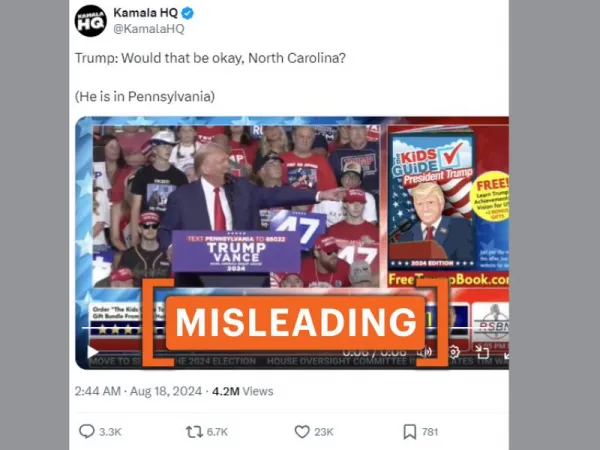By: Ankita Kulkarni
August 19 2024
 A screenshot of viral post claiming that video shows Former U.S. President Donald Trump referred to his Pennsylvania rally as North Carolina. (Source: X/Screenshot/Modified by Logically Facts)
A screenshot of viral post claiming that video shows Former U.S. President Donald Trump referred to his Pennsylvania rally as North Carolina. (Source: X/Screenshot/Modified by Logically Facts)
The original video shows Trump acknowledging a group of North Carolina women attending his rallies. He did not forget the state name.
What is the claim?
A six-second clip shared on X (formerly Twitter) by the official page of Kamala Harris' presidential campaign (archived here) claims that former U.S. President Donald Trump confused Pennsylvania (PA) with North Carolina during an election rally held in Wilkes-Barre, PA.
The caption read, "Trump: Would that be okay, North Carolina? (He is in Pennsylvania)." At the time of writing, the post had garnered 23,000 likes and 6,700 reposts.
Similar claims made by other posters are archived here, here, here, and here.
Screenshots of viral posts circulating on social media. (Source: X/Screenshot/Modified by Logically Facts)
However, we found that Trump was referring to a group of women from North Carolina who regularly attended his rallies, not the name of the state where the rally was held.
What did we find?
A reverse image search of the viral clip led us to a video uploaded by C-Span (archived here) on August 17, 2024, titled "Donald Trump Campaigns in Wilkes-Barre, PA." At the 9:37 timestamp, we can hear Trump talking about being re-elected as president in the 2024 elections and pointing to a group of people he calls "Front row joes" in the audience, acknowledging their presence in many rallies.
He then continues, "But I have another group from a place called North Carolina. Has anybody ever heard of north ... we love North Carolina. The beautiful ladies over there, this is number what? - (he then checks how many rallies the women have attended) - 217, so this is number 217, and supposedly they're happily married." He then states, "They are great women, and they have been with us from the very beginning in 2016."
At the 26:30 mark, justifying the length of his speech at some rallies, he says, "How would you like it? A guy is waiting with his family for three days, four days; they have a tent. The tent is set up. And they wait. And I walk in, speak for 15 minutes, and leave. Would that be okay, North Carolina? I don't think so," said Trump, looking back at the group of women he'd acknowledged. This is the clipped portion used in the viral post, claiming that he forgot the state name during a rally.
The longer version of the viral clip shows that he referred to a group of women from North Carolina without confusing the state's name.
This video was also uploaded to YouTube by PBS NewsHour on August 18 (archived here), which live-streamed Trump's campaign in Pennsylvania. In the video, at 12:22 timestamp, he introduces the group of women from North Carolina, and at 28:48, we can see Trump asking the group if it is okay for him to cut short his speeches at the rally.
Moreover, at the rally's start, Trump can be heard saying, "Thank you very much, Pennsylvania, and I love Pennsylvania," showing that he was aware of the state name, contrary to what the viral posts claim.
The verdict
The full footage from Trump's rally in Pennsylvania establishes that Trump was referring to a group of women from North Carolina and not confusing the state's name, as incorrectly claimed in the viral posts.
Follow Logically Facts' coverage and fact-checking of the U.S. Election 2024 here.